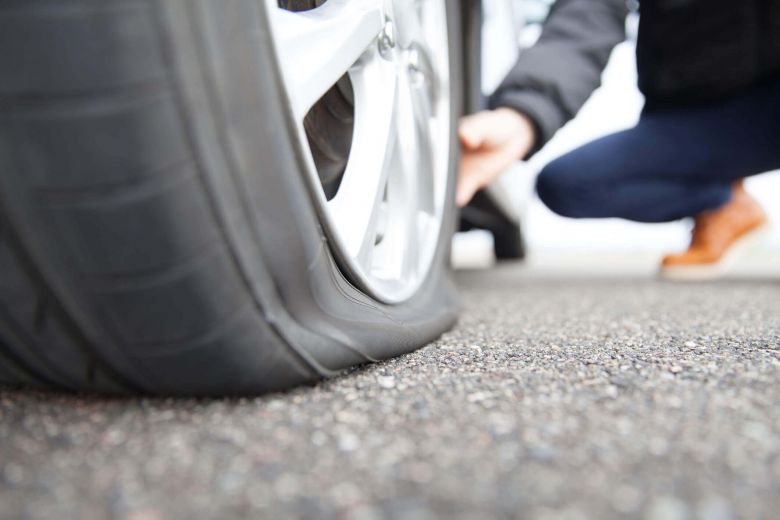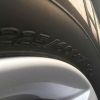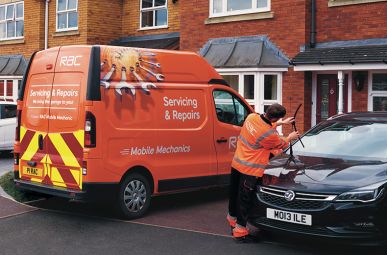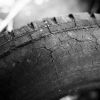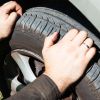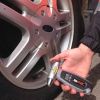Unlike a sudden puncture, which can cause a tyre to deflate rapidly, a slow puncture causes a steady loss of air pressure – no matter if you are driving or the vehicle is parked.
Given that your tyres are the only contact point between your car and the road, it's vital that you spot the warning signs of a slow puncture and act before it becomes a serious tyre safety issue.
In this guide, we reveal the common causes for a slow puncture and tell you what you should do if you experience one with your vehicle.
How can a slow puncture happen?
A slow puncture is usually caused by a small puncture that allows air to gradually escape from the tyre.
Common causes for a small puncture include:
- A nail, screw or some other sharp metal object embedded in the tread
- Road debris
- Potholes
Faulty valve
Another regular issue seen by mechanics when it comes to slowly deflating tyres is a faulty valve stem. This is the small rubber protrusion through which air is added to the tyre when changing the tyre pressure. If the valve is damaged, it can lead to slow air leakage.
Poor car maintenance
Improper car maintenance or tyre safety management can lead to cracked, bulging or damaged tyres. Any of these can lead to a loss of air in the tyre and impact its structural integrity.
Poorly fitted tyres and damaged or corroded wheels can also result in air escaping from the tyre. If this happens, then the wheel and the tyre may need to be replaced.
Symptoms of a slow tyre puncture
Detecting a slow tyre puncture can be challenging because the pressure loss is slow and steady, which means it may not be easily noticeable to drivers.
The easiest way to keep an eye out for a deflating tyre, is to regularly check your tyre pressure. This can be done at home with a special device or at your local fuel station.
Signs of a slow puncture
- Inflating tyre more often: A slow puncture will require regular top ups for the tyre to replace the lost air
- Uneven tyre wear: A slow puncture can result in one side of the tyre wearing more quickly
- Vehicle pulling to one side: Your car may pull to one side, especially when braking or accelerating hard
- Sluggish road handling: Road handling of the vehicle may be less responsive or heavier when cornering
- TPMS warning light: The Tyre Pressure Monitoring System (TPMS) may issue alerts to warn you of loss of tyre pressure
If your vehicle experiences one or more of these symptoms, take your car to your local trusted garage and look to buy new tyres.
If you continue to drive on underinflated tyres, this can lead to further damage to your vehicle and compromise your safety on the road.
How long does a slow puncture take to go down?
As there are many ways in which a tyre can suffer from a slow puncture, there is no way to give a definitive time for how long the air has until it leaves the tyre.
This can take hours, days or even up to a week.
However, it is important to get it seen by a mobile mechanic or taken to a local garage as soon as possible.
Can you fix a slow tyre puncture?
Although getting a new set of tyres is the best option, you can sometimes repair a slow tyre puncture.
However, this will need to be done by a mechanic or specialised ‘tyre technician’.
They may be able to make a temporary fix to the tyre as long as there is no serious damage.
If the puncture is less than 1/4 inch (6mm) in diameter, then there is a chance it can be saved. Any larger and it is not repairable.
However, if there is a puncture anywhere on the sidewall, then the tyre cannot be repaired at all.
Although it is technically possible to repair older and more worn out tyres, it is not worth it as they will need to be replaced imminently. This is also the case if it is an older tyre that has already had some repairs done to it.
At the annual MOT or at your next car service, your tyres will be professionally checked for any damage.
Sometimes this can lead to an immediate replacement of the tyre – or they will give you an indication of when you should get a new set of tyres.
It's important to note that tyre repair is not always a guaranteed solution.
Can you drive with a slow tyre puncture?
Driving with a slow tyre puncture is generally not recommended for several reasons.
- The air loss could start leaking air at a faster rate and result in a flat tyre
- A slow puncture can make the vehicle unsafe to drive, affecting the handling, stability, and braking performance
- Continuing to drive with a damaged tyre can cause further problems with the vehicle – and will cost a lot more to fix
Get a car service at home
RAC Mobile Mechanics can come to you, saving you the hassle of going to a garage.



